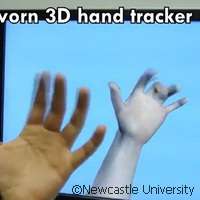Researchers use 'digits' to change the channel

A team of inventors from across Europe have done away with traditional remotes and have developed a sensor about the size of a wrist watch which is able to track the 3D movement of the hand and allows the user to remotely control any device. The researchers believe that their device could replace your television remote and games controller, and could even control your mobile phone - with just a wave of the hand. Their controller, 'Digits', was presented at the 25th Association for Computing Machinery Symposium on User Interface Software and Technology (ACM UIST).
Their invention represents a major breakthrough as it allows, for the first time, 3D interactions without being tied to any external hardware. Digits maps finger movement and orientation and it gives the user remote control anytime, anywhere, according to its developers, even allowing you to answer your phone while it's still in your pocket and you're walking down the street.
Digits was developed by David Kim, a Microsoft Research (MSR)-funded PhD student from Newcastle University's Culture Lab; Otmar Hilliges, Shahram Izadi, Alex Butler and Jiawen Chen of MSR Cambridge; Iason Oikonomidis of Greece's Foundation for Research & Technology; and Professor Patrick Olivier of Newcastle University's Culture Lab.
'The Digits sensor doesn't rely on any external infrastructure so it is completely mobile,' explains David Kim. 'This means users are not bound to a fixed space. They can interact while moving from room to room or even running down the street. What Digits does is finally take 3-D interaction outside the living room.'
To fulfil their ambitious target, Digits had to be lightweight, have a small power consumption footprint, and have the potential to be as small and comfortable as a watch. At the same time they also wanted Digits to accomplish a lot, such as deliver superior gesture sensing and 'understand' the human hand, from wrist orientation to the angle of each finger joint, so that interaction would not be limited to 3D points in space. Digits had to understand what the hand is trying to express, even while inside a pocket.
David Kim adds: 'We needed a system that enabled natural 3-D interactions with bare hands, but with as much flexibility and accuracy as data gloves. We wanted users to be able to interact spontaneously with their electronic devices using simple gestures without even having to reach for them. Can you imagine how much easier it would be if you could answer your mobile phone while it's still in your pocket or buried at the bottom of your bag?'
Their prototype, which they showcased at the prestigious ACM UIST 2012 conference, includes an infrared (IR) camera, IR laser line generator, IR diffuse illuminator, and an inertial-measurement unit (IMU) track.
Shahram Izadi explains the challenges they had to overcome, such as extrapolating natural-looking hand motions from a sparse sampling of the key points sensed by the camera.
'We had to understand our own body parts first before we could formulate their workings mathematically,' Shahram Izadi explains. 'We spent hours just staring at our fingers. We read dozens of scientific papers about the biomechanical properties of the human hand. We tried to correlate these five points with the highly complex motion of the hand. In fact, we completely rewrote each kinematic model about three or four times until we got it just right.'
The team agrees that the most exciting moment of the project came when team members saw the models succeed. 'At the beginning, the virtual hand often broke and collapsed. It was always very painful to watch,' David Kim explains. 'Then, one day, we radically simplified the mathematical model, and suddenly, it behaved like a human hand. It felt absolutely surreal and immersive, like in the movie Avatar. That moment gave us a big boost!'
Digits is just the tip of the iceberg; the researchers are also experimenting to further develop their invention. 'By understanding how one part of the body works and knowing what sensors to use to capture a snapshot,' Shahram Izadi says, 'Digits offers a compelling look at the possibilities of opening up the full expressiveness and dexterity of one of our body parts for mobile human-computer interaction.'
Provided by CORDIS




















